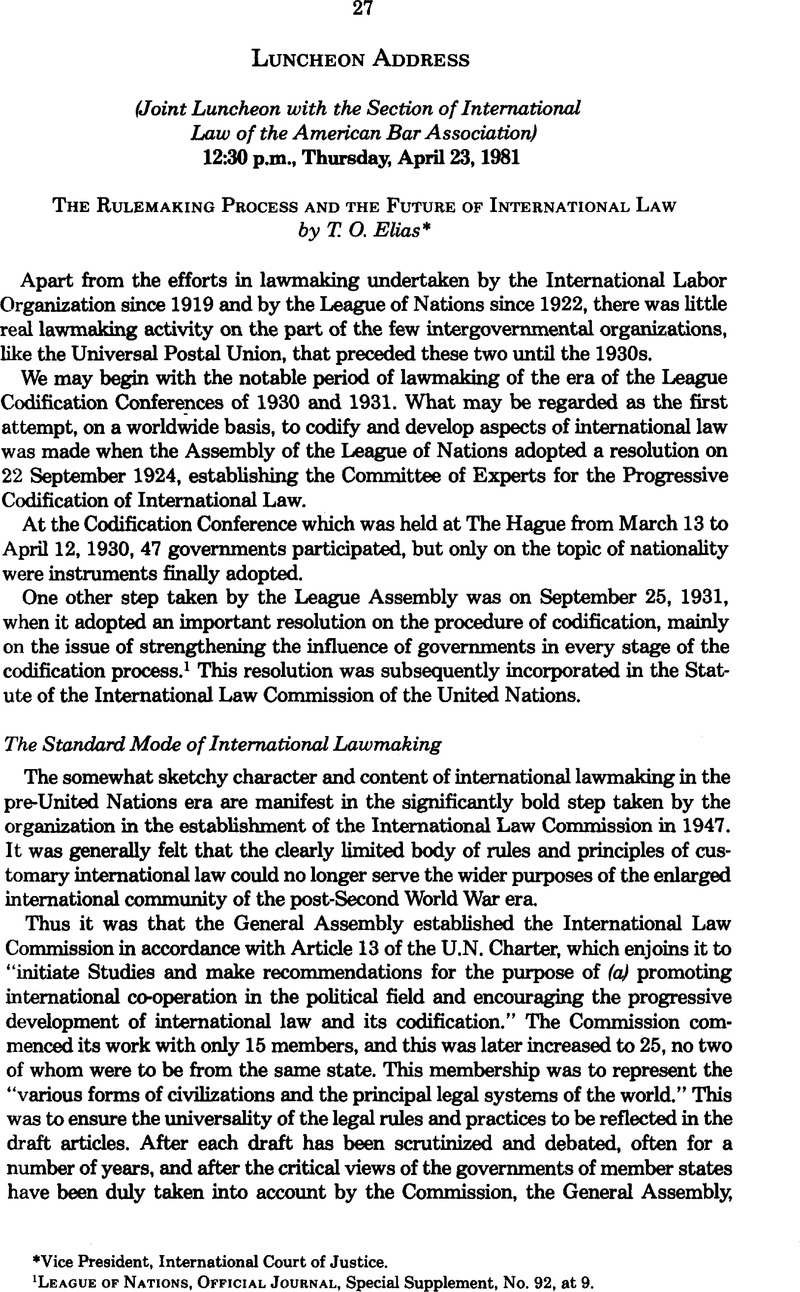No CrossRef data available.
Article contents
The Rulemaking Process and the Future of International Law
Published online by Cambridge University Press: 28 February 2017
Abstract

- Type
- Luncheon Address
- Information
- Copyright
- Copyright © American Society of International Law 1981
References
1 League of Nations, Official Journal, Special Supplement, No. 92, at 9.
2 This is most infrequent in the practice of the United Nations.
3 See United Nations, the Work of the International law Commission, (3d Ed. 1980), for a detailed account of its activities from that time up to date.
4 1 U.N. Commission Int'l Trade L. Y. B. (1968-1970), at 8, para. 3.
5 Id at 59-60.
6 See Resolution A/35/141 for the text.
7 The draft Charter had been initiated by two scientific U.N. organs
8 See J. Detter, Law-making by International Organizations (1965); Johnson, The Effect of Resolutions of the General Assembly of the United Nations, 32 BRIT. Y. B. INT'L L. (1955-56); and R. Higgins, the Development of International Law Through the Political Organs of the United Nations (1963).
9 See the various references to the General Assembly resolutions affirming the validity of the new principle of the right of peoples to self-determination and political independence in Advisory Opinion on Legal Consequences for States of the Continued Presence of South Africa in Namibia (South-West Africa) notwithstanding Security Council Resolution 276 (1970), [1971] I.C.J. 16; Advisory Opinion on Western Sahara, [1975] I.C.J. 12. See also General Assembly Resolution Terminating South Africa's Mandate over South West Africa, Oct. 27,1966, Resolution No. 2145 XXI.
10 Consider the definite pronouncements of the International Court of Justice in Advisory Opinion on Reservations to the Convention on the Prevention and Punishment of the Crime of Genocide, [1951] I.C.J. 15, regarding the binding character of the Convention adopted by the U.N. General Assembly.
11 See for example, Jenks, The Scope of International Law, 32 BRIT. Y. B. INT'L. L. (1956), 8; and Fitzmaurice, Law and Procedure of the International Court of Justice 1951-54, 34 BRIT. Y. B. INT'L L., 1958. The better approach to the new developments in international lawmaking seems, however, to be discernible in certain writers, like Judge Philip C. Jessup in his Transnational Law (1956); W. Friedmann, the Changing Structure of International Law, 152 ff. (1964); and Jennings, The Progress of International Law, in 34 BRIT. Y. B. INT'L L., 1958.
12 We need not emphasize, for example, the I.C.J. Advisory Opinion in Certain Expenses of the United Nations (Article 17, paragraph 2 of the Charter), [1962] I.C.J. 151, which was based on the series of resolutions of the General Assembly and of the Security Council, establishing the peacekeeping force in the Congo in respect of which the U.N. expenses had been undertaken and held enforceable.
13 Note in this connection the controversial Article 81(2)(c) of the 1976 New Rules of the International Court of Justice, suggesting that an intervener should have a jurisdictional link with the parties to a case before the Court, as a condition of the Court's permitting it to intervene, when there is no explicit requirement in the relevant article S.62 of the Statute of the Court.


